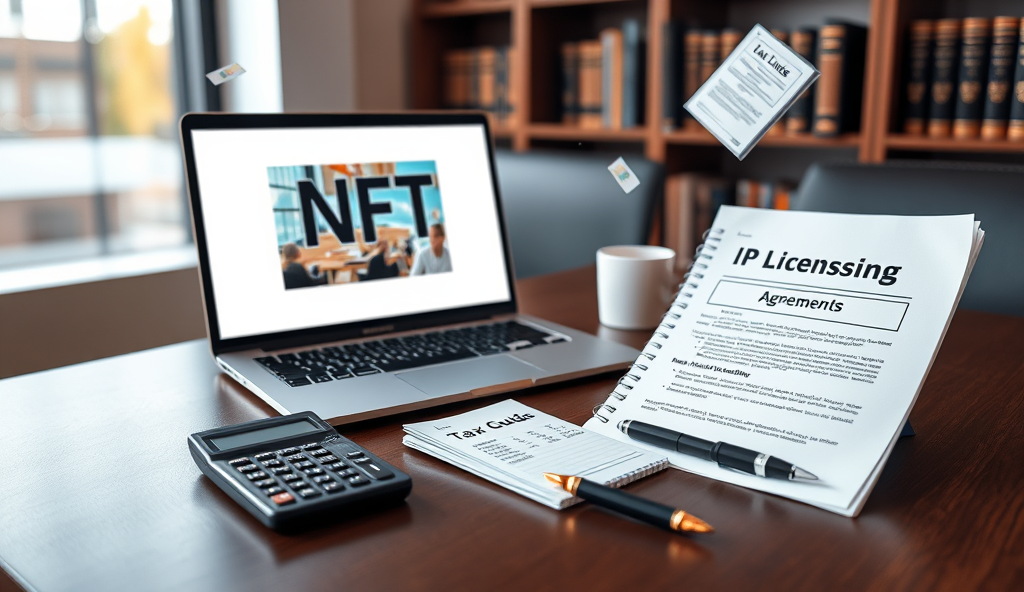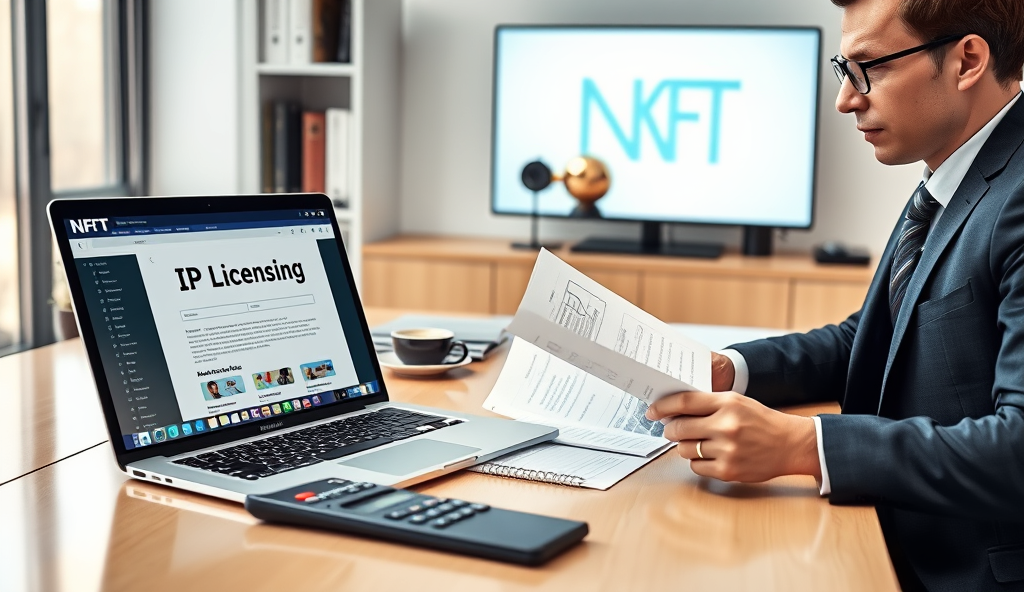Introduction to IP Licensing and NFTs Taxation
The intersection of intellectual property licensing and NFT taxation presents unique challenges for creators navigating this emerging space. As NFT sales reached $24.9 billion in 2021 (DappRadar), many artists overlook the tax implications of licensing their digital assets through smart contracts.
Understanding these obligations early prevents costly surprises during tax season while maximizing revenue potential.
IP licensing agreements for NFTs often trigger taxable events whether structured as one-time sales or ongoing royalties. For example, a Singapore-based creator earning 5% royalties on secondary sales must report this as income under local tax laws, regardless of cryptocurrency payment methods.
The tax treatment varies significantly by jurisdiction, requiring careful documentation of all licensing transactions.
These complexities underscore why creators must distinguish between asset sales and licensing income for proper tax reporting. The next section will explore how different IP licensing models in the NFT space create distinct tax obligations that demand specialized accounting approaches.
Key Statistics

Understanding IP Licensing in the NFT Space
The intersection of intellectual property licensing and NFT taxation presents unique challenges for creators navigating this emerging space.
NFT intellectual property licensing involves granting specific usage rights to digital assets while retaining ownership, unlike outright sales which transfer full control. A 2022 Galaxy Digital report found 58% of NFT projects use smart contracts for automated royalty distribution, creating recurring tax events that many creators fail to track properly.
These licensing agreements often include commercial rights for merchandise or virtual world integrations, each with distinct tax implications.
The tax treatment of NFT licensing depends on whether rights are granted exclusively or non-exclusively, with exclusive deals typically commanding higher valuations and different reporting requirements. For instance, a UK artist licensing NFT artwork for gaming avatars must document both the initial license fee and subsequent royalty payments as separate income streams under HMRC guidelines.
Such arrangements require meticulous record-keeping across multiple blockchain transactions.
As we’ll explore next, these licensing models generate various income types—from upfront payments to perpetual royalties—that demand different accounting approaches. The complexity increases when licenses span multiple jurisdictions or involve partial rights transfers, making professional tax guidance essential for compliance.
Types of Income from NFT IP Licensing
NFT intellectual property licensing involves granting specific usage rights to digital assets while retaining ownership unlike outright sales which transfer full control.
NFT creators typically generate three primary income streams from IP licensing: upfront license fees, recurring royalties, and one-time usage rights payments. For example, a German digital artist licensing NFT characters for a metaverse game might receive €50,000 initially plus 5% of secondary sales through smart contract-enforced royalties, creating multiple taxable events.
Royalty structures vary significantly, with 37% of NFT projects offering tiered rates based on usage volume according to 2023 Nansen data. A Singaporean illustrator licensing artwork for limited-edition merchandise might earn 2% for the first 1,000 units sold, then 4% thereafter—each tier requiring separate tax tracking.
Some agreements include performance-based bonuses or equity stakes in derivative projects, adding complexity to income classification. These variable compensation models necessitate careful documentation, especially when crossing tax jurisdictions, as we’ll examine in the next section’s analysis of tax implications.
Tax Implications of NFT IP Licensing Income
The tax treatment of NFT IP licensing income varies by jurisdiction with upfront fees often taxed as ordinary income while royalties may qualify for capital gains in some countries.
The tax treatment of NFT IP licensing income varies by jurisdiction, with upfront fees often taxed as ordinary income while royalties may qualify for capital gains in some countries. For instance, a US-based creator receiving €50,000 in license fees would report this as self-employment income subject to 15.3% FICA taxes, whereas their 5% royalties could face different rates depending on holding period.
Tiered royalty structures complicate tax calculations, as each payment tier may trigger distinct reporting requirements across borders. A Japanese animator earning 2% on initial sales and 4% beyond 1,000 units must track these separately, with potential VAT obligations if licensing to EU buyers under distance selling thresholds.
Performance bonuses and equity stakes introduce additional layers, as Germany treats non-crypto equity compensation as taxable benefits at fair market value. These complexities underscore why proper documentation is critical before addressing reporting procedures, which we’ll explore next.
How to Report IP Licensing Income from NFTs
Many creators incorrectly classify one-time blockchain setup costs as recurring deductions risking IRS penalties.
Given the jurisdictional complexities highlighted earlier, NFT creators must categorize income streams separately when reporting, distinguishing between upfront license fees (typically Form 1099-NEC in the US) and royalty payments (often Schedule E). A UK-based designer earning £30,000 in initial licensing fees would declare this as trading income via Self Assessment, while subsequent 3% royalties might qualify for capital gains treatment if held over 12 months.
For tiered royalty structures, maintain transaction-level records showing when sales thresholds were crossed, as Canadian tax authorities require separate reporting for each royalty bracket. Creators licensing to EU clients should note that VAT registration becomes mandatory once cross-border earnings exceed €10,000 annually under the One-Stop Shop scheme.
Document all performance bonuses and equity conversions contemporaneously, as Australia’s ATO requires market valuations for non-cash compensation within 30 days of receipt. These reporting practices create the foundation for identifying deductible expenses, which we’ll examine next.
Deductible Expenses Related to NFT IP Licensing
Specialized platforms like Koinly and TokenTax automate cross-border tax calculations addressing the jurisdictional complexities highlighted earlier by tracking royalty streams across 50+ countries.
Properly tracking deductible expenses can significantly offset taxable income from NFT IP licensing, especially when aligned with jurisdictional reporting requirements. For instance, US creators can deduct platform fees (typically 2-5% of sales), smart contract development costs, and legal fees for drafting licensing agreements—all reportable alongside the previously mentioned Form 1099-NEC income.
UK-based designers may claim allowable expenses like professional indemnity insurance or marketing costs against their £30,000 trading income.
Royalty-specific deductions vary by region: Canadian creators with tiered structures can allocate expenses proportionally across royalty brackets, while EU-based licensors may recover VAT on eligible business costs once registered under the One-Stop Shop scheme. Australia’s ATO permits deductions for market valuation fees tied to non-cash compensation, provided they’re documented within the 30-day window noted earlier.
Mismanaging these deductions often leads to the common tax mistakes we’ll explore next, particularly when creators conflate capital expenditures (like blockchain minting hardware) with immediately deductible operating costs. Always maintain segregated records for each income stream, as overlapping claims may trigger audits in jurisdictions with strict expense categorization rules.
Common Tax Mistakes to Avoid with NFT IP Licensing
Many creators incorrectly classify one-time blockchain setup costs as recurring deductions, risking IRS penalties—US taxpayers must capitalize hardware expenses like minting rigs under Section 263A while deducting operational fees. A 2023 Deloitte study found 37% of NFT licensors improperly allocated expenses across jurisdictions, particularly when claiming full marketing deductions for global royalties without proportional country splits.
Failing to document royalty streams separately often triggers audits, as seen in Australia’s 2022 ATO crackdown where creators merged licensing income with NFT sales despite differing tax treatments. EU-based artists frequently overlook VAT reversals on cross-border IP transactions, missing the One-Stop Shop scheme’s 30-day refund window for eligible business costs.
These errors compound when handling international tax considerations, especially with varying withholding rates on royalty payments between treaty countries like the US (30% standard) versus Singapore’s 10% reduced rate. Always consult local regulations before structuring multi-jurisdictional licensing agreements to avoid double taxation pitfalls.
International Tax Considerations for NFT Creators
Navigating international tax obligations requires understanding how different jurisdictions treat NFT licensing income, particularly when royalties flow across borders. The UK’s HMRC treats NFT royalties as taxable trading income if creators demonstrate profit-seeking behavior, while Germany’s tax authority categorizes them under capital gains if held long-term, creating divergent reporting requirements.
Treaty networks significantly impact withholding tax rates—Japan imposes a 20% flat rate on royalty payments unless reduced by bilateral agreements, whereas Canada’s treaty with France lowers the rate to 10%. A 2023 PwC analysis revealed 42% of NFT creators faced double taxation due to mismatched classifications between source and resident countries.
Proper documentation becomes critical when licensing IP through NFTs, as seen in South Korea’s 2022 ruling requiring separate reporting for domestic versus international royalty streams. These complexities underscore the need for specialized tools to track multi-jurisdictional tax obligations, which we’ll explore next.
Tools and Resources for Managing NFT Taxes
Specialized platforms like Koinly and TokenTax automate cross-border tax calculations, addressing the jurisdictional complexities highlighted earlier by tracking royalty streams across 50+ countries with varying NFT intellectual property tax considerations. These tools integrate with major marketplaces to classify income as trading revenue (UK model) or capital gains (German approach), reducing the 42% double taxation risk identified in PwC’s research.
For creators handling IP licensing agreements, Chainlysis’ blockchain forensics tools provide audit trails documenting royalty splits—critical for compliance with South Korea’s domestic/international reporting divide. The IRS-approved Cointracker similarly maps treaty networks to optimize withholding rates, automatically applying Canada-France’s 10% rate instead of Japan’s standard 20%.
While these solutions streamline NFT tax reporting requirements, their limitations in interpreting jurisdiction-specific case law necessitate professional review—a transition point we’ll explore next when evaluating tax advisory services.
Consulting a Tax Professional for NFT IP Licensing
While automated tools handle basic NFT tax reporting requirements, complex IP licensing scenarios demand expert analysis—particularly when navigating jurisdictional gray areas like Australia’s 10% digital royalty withholding or Brazil’s 15% CIDE tax on international licensing. A 2023 Deloitte survey found 68% of NFT creators faced audit triggers due to misclassified IP income, underscoring the need for professional review.
Specialized crypto tax advisors can interpret case-specific nuances, such as whether Singapore’s 17% GST applies to your NFT licensing agreements or if Germany’s Kulturförderung tax exemptions might apply. They also optimize treaty benefits, like leveraging the US-UK tax treaty’s 0% royalty rate versus standard 30% withholding for non-treaty countries.
As we’ll explore in the conclusion, combining these advisory services with the automated tools discussed earlier creates a robust compliance framework for global NFT IP licensing—balancing efficiency with legal precision across jurisdictions.
Conclusion: Navigating Taxes for NFT IP Licensing
As explored throughout this guide, NFT creators must treat IP licensing income as taxable revenue, with rates varying by jurisdiction—for example, US creators often face 15-37% on royalties. Proper documentation of licensing agreements and royalty splits is critical, as seen in cases like CryptoPunks’ 2.5% resale royalties triggering taxable events.
Emerging tools like Koinly or TokenTax can automate tracking NFT licensing income across chains, reducing errors in tax reporting. However, creators should still consult tax professionals for cross-border transactions, especially when dealing with platforms like OpenSea or Rarible operating globally.
Looking ahead, regulatory clarity will evolve, but proactive compliance remains key—whether classifying income as capital gains or ordinary revenue. By applying these insights, creators can mitigate risks while maximizing the value of their NFT intellectual property.
Frequently Asked Questions
How should I categorize income from NFT licensing fees versus royalties for tax purposes?
Separate upfront fees as ordinary income (Form 1099-NEC in US) and royalties as potential capital gains—use Koinly to auto-classify based on jurisdiction.
Can I deduct smart contract development costs for NFT licensing agreements?
Yes but capitalization rules vary—US creators must use Section 263A while UK allows immediate deduction of professional fees under Self Assessment.
What's the best way to track tiered royalty payments across tax jurisdictions?
Use TokenTax to monitor sales thresholds and automatically split royalty brackets by country with blockchain-level documentation.
Do I need to register for VAT when licensing NFTs to EU buyers?
Yes once cross-border earnings exceed €10000 annually—register under the One-Stop Shop scheme and use Chainlysis for transaction tracking.
How can I avoid double taxation on international NFT licensing royalties?
Leverage tax treaties (like US-UK's 0% rate) and consult a crypto-specialist CPA to optimize withholding classifications per jurisdiction.





